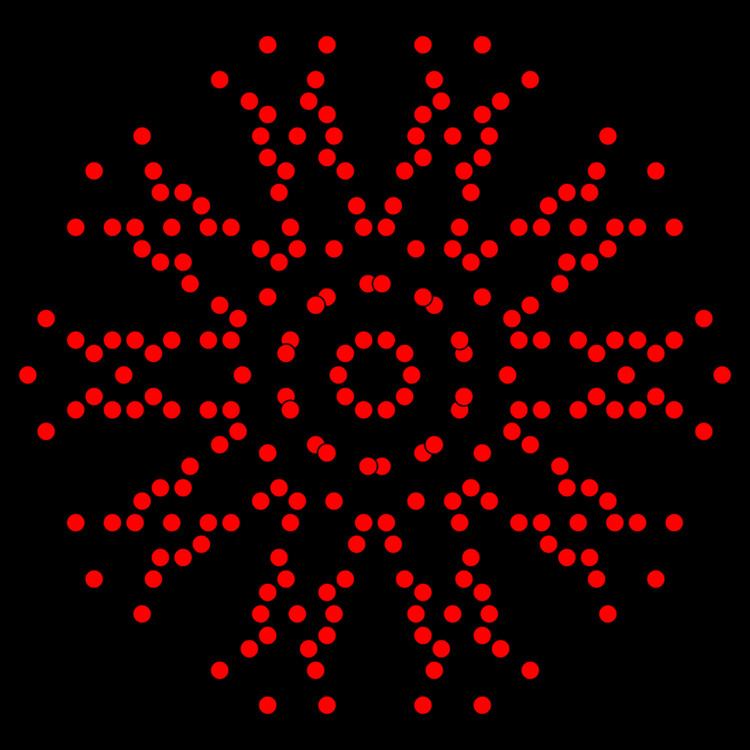 | ||
In geometry, a uniform 5-polytope is a five-dimensional uniform polytope. By definition, a uniform 5-polytope is vertex-transitive and constructed from uniform 4-polytope facets.
Contents
- History of discovery
- Regular 5 polytopes
- Convex uniform 5 polytopes
- Reflection families
- Enumerating the convex uniform 5 polytopes
- The A5 family
- The B5 family
- The D5 family
- Uniform prismatic forms
- A4 A1
- B4 A1
- F4 A1
- H4 A1
- Grand antiprism prism
- Regular and uniform honeycombs
- Compact Regular tessellations of hyperbolic 4 space
- Regular and uniform hyperbolic honeycombs
- References
The complete set of convex uniform 5-polytopes has not been determined, but most can be made as Wythoff constructions from a small set of symmetry groups. These construction operations are represented by the permutations of rings of the Coxeter diagrams.
History of discovery
Regular 5-polytopes
Regular 5-polytopes can be represented by the Schläfli symbol {p,q,r,s}, with s {p,q,r} polychoral facets around each face. There are exactly three such regular polytopes, all convex:
There are no nonconvex regular polytopes in 5 or more dimensions.
Convex uniform 5-polytopes
There are 104 known convex uniform 5-polytopes, plus a number of infinite families of duoprism prisms, and polygon-polyhedron duoprisms. All except the grand antiprism prism are based on Wythoff constructions, reflection symmetry generated with Coxeter groups.
Reflection families
The 5-simplex is the regular form in the A5 family. The 5-cube and 5-orthoplex are the regular forms in the B5 family. The bifurcating graph of the D6 family contains the pentacross, as well as a 5-demicube which is an alternated 5-cube.
Fundamental families
Uniform prisms There are 5 finite categorical uniform prismatic families of polytopes based on the nonprismatic uniform 4-polytopes:
There is one infinite family of 5-polytopes based on prisms of the uniform duoprisms {p}×{q}×{ }:
Uniform duoprisms
There are 3 categorical uniform duoprismatic families of polytopes based on Cartesian products of the uniform polyhedra and regular polygons: {q,r}×{p}:
Enumerating the convex uniform 5-polytopes
That brings the tally to: 19+31+8+46+1=105
In addition there are:
The A5 family
There are 19 forms based on all permutations of the Coxeter diagrams with one or more rings. (16+4-1 cases)
They are named by Norman Johnson from the Wythoff construction operations upon regular 5-simplex (hexateron).
The A5 family has symmetry of order 720 (6 factorial). 7 of the 19 figures, with symmetrically ringed Coxeter diagrams have doubled symmetry, order 1440.
The coordinates of uniform 5-polytopes with 5-simplex symmetry can be generated as permutations of simple integers in 6-space, all in hyperplanes with normal vector (1,1,1,1,1,1).
The B5 family
The B5 family has symmetry of order 3840 (5!×25).
This family has 25−1=31 Wythoffian uniform polytopes generated by marking one or more nodes of the Coxeter diagram.
For simplicity it is divided into two subgroups, each with 12 forms, and 7 "middle" forms which equally belong in both.
The 5-cube family of 5-polytopes are given by the convex hulls of the base points listed in the following table, with all permutations of coordinates and sign taken. Each base point generates a distinct uniform 5-polytope. All coordinates correspond with uniform 5-polytopes of edge length 2.
The D5 family
The D5 family has symmetry of order 1920 (5! x 24).
This family has 23 Wythoffian uniform polyhedra, from 3x8-1 permutations of the D5 Coxeter diagram with one or more rings. 15 (2x8-1) are repeated from the B5 family and 8 are unique to this family.
Uniform prismatic forms
There are 5 finite categorical uniform prismatic families of polytopes based on the nonprismatic uniform 4-polytopes:
A4 × A1
This prismatic family has 9 forms:
The A1 x A4 family has symmetry of order 240 (2*5!).
B4 × A1
This prismatic family has 16 forms. (Three are shared with [3,4,3]×[ ] family)
The A1×B4 family has symmetry of order 768 (254!).
F4 × A1
This prismatic family has 10 forms.
The A1 x F4 family has symmetry of order 2304 (2*1152). Three polytopes 85, 86 and 89 (green background) have double symmetry [[3,4,3],2], order 4608. The last one, snub 24-cell prism, (blue background) has [3+,4,3,2] symmetry, order 1152.
H4 × A1
This prismatic family has 15 forms:
The A1 x H4 family has symmetry of order 28800 (2*14400).
Grand antiprism prism
The grand antiprism prism is the only known convex non-Wythoffian uniform 5-polytope. It has 200 vertices, 1100 edges, 1940 faces (40 pentagons, 500 squares, 1400 triangles), 1360 cells (600 tetrahedra, 40 pentagonal antiprisms, 700 triangular prisms, 20 pentagonal prisms), and 322 hypercells (2 grand antiprisms , 20 pentagonal antiprism prisms , and 300 tetrahedral prisms ).
Regular and uniform honeycombs
There are five fundamental affine Coxeter groups, and 13 prismatic groups that generate regular and uniform tessellations in Euclidean 4-space.
There are three regular honeycombs of Euclidean 4-space:
Other families that generate uniform honeycombs:
Non-Wythoffian uniform tessellations in 4-space also exist by elongation (inserting layers), and gyration (rotating layers) from these reflective forms.
Compact Regular tessellations of hyperbolic 4-space
There are five kinds of convex regular honeycombs and four kinds of star-honeycombs in H4 space:
There are four regular star-honeycombs in H4 space:
Regular and uniform hyperbolic honeycombs
There are 5 compact hyperbolic Coxeter groups of rank 5, each generating uniform honeycombs in hyperbolic 4-space as permutations of rings of the Coxeter diagrams. There are also 9 paracompact hyperbolic Coxeter groups of rank 5, each generating uniform honeycombs in 4-space as permutations of rings of the Coxeter diagrams. Paracompact groups generate honeycombs with infinite facets or vertex figures.
